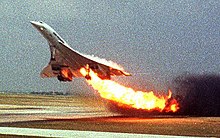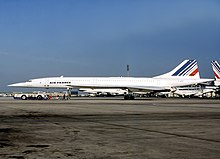Air France Flight 4590

Flight 4590 during takeoff
|
|
| Accident summary | |
|---|---|
| Date | 25 July 2000 |
| Summary | Foreign object damage caused by mechanical failure on DC-10 |
| Site | Gonesse, France |
| Total fatalities | 113 |
| Total survivors | 0 |
| First aircraft | |
 Concorde F-BTSC – Charles de Gaulle (CDG Airport) – 5 July 1985 |
|
| Type | Aérospatiale-BAC Concorde |
| Operator | Air France |
| Registration | F-BTSC |
| Flight origin | Charles de Gaulle Airport |
| Destination | John F. Kennedy International Airport |
| Passengers | 100 |
| Crew | 9 |
| Fatalities | 113 (4 on ground) |
| Survivors | 0 |
| Second aircraft | |
 The DC-10 involved, seen here operated by Eastern Airlines at London Gatwick Airport |
|
| Type | McDonnell Douglas DC-10-30 |
| Operator | Continental Airlines |
| Registration | N13067 |
| Flight origin | Charles de Gaulle Airport |
| Destination | Newark International Airport |
Air France Flight 4590 was a scheduled international flight from Paris, France, to New York City, on the Aérospatiale-BAC Concorde. On 25 July 2000, at time 16:43 CET, the aircraft serving the flight, registration F-BTSC, ran over debris on the runway during takeoff, blowing a tyre and puncturing a fuel tank, leading to fire and engine failure. All 100 passengers and nine crew members aboard the Concorde died when it crashed into a hotel in nearby Gonesse; on the ground, four people were killed and one was critically injured.
The flight was chartered by German company Peter Deilmann Cruises; the passengers were on their way to board the cruise ship MS Deutschland in New York City for a 16-day cruise to Manta, Ecuador. This was the only fatal Concorde accident during its 27-year operational history.
Post-accident investigation revealed that the aircraft was at or over the maximum takeoff weight for ambient temperature and other conditions, and 810 kilograms (1,790 lb) over the maximum structural weight. As it left the gate, it was loaded such that the centre of gravity was aft of the take-off limit. Fuel transfer during taxiing left the number five wing tank 94% full. A 12-inch spacer that normally keeps the left main landing gear in alignment had not been replaced after recent maintenance; however, the French Bureau for Accident Investigation concluded that this did not contribute to the accident. The wind at the airport was light and variable that day, and was reported to the cockpit crew as an eight knot tailwind as they lined up on runway 26R.
Five minutes before the Concorde departed, a Continental Airlines DC-10 heading for Newark, New Jersey took off from the same runway and lost a titanium alloy strip (part of the engine cowl, identified as a wear strip) that was about 435 millimetres (17.1 in) long, 29 to 34 millimetres (1.1 to 1.3 in) wide and 1.4 millimetres (0.055 in) thick.
...
Wikipedia
